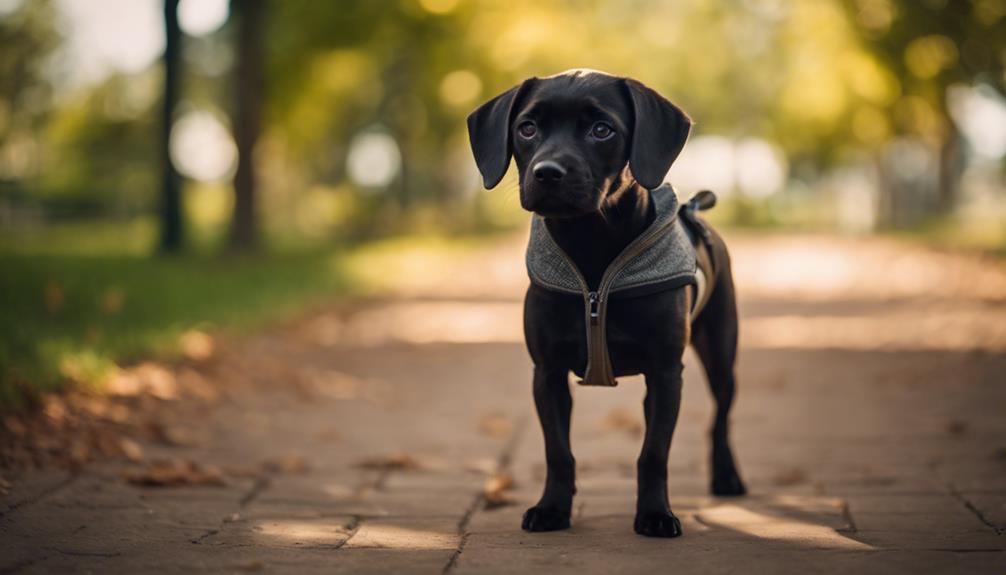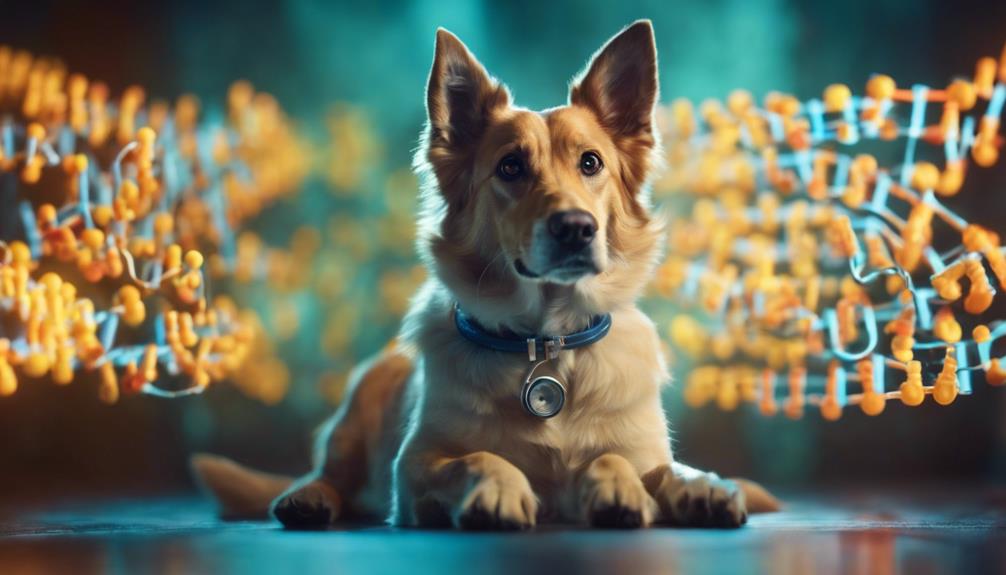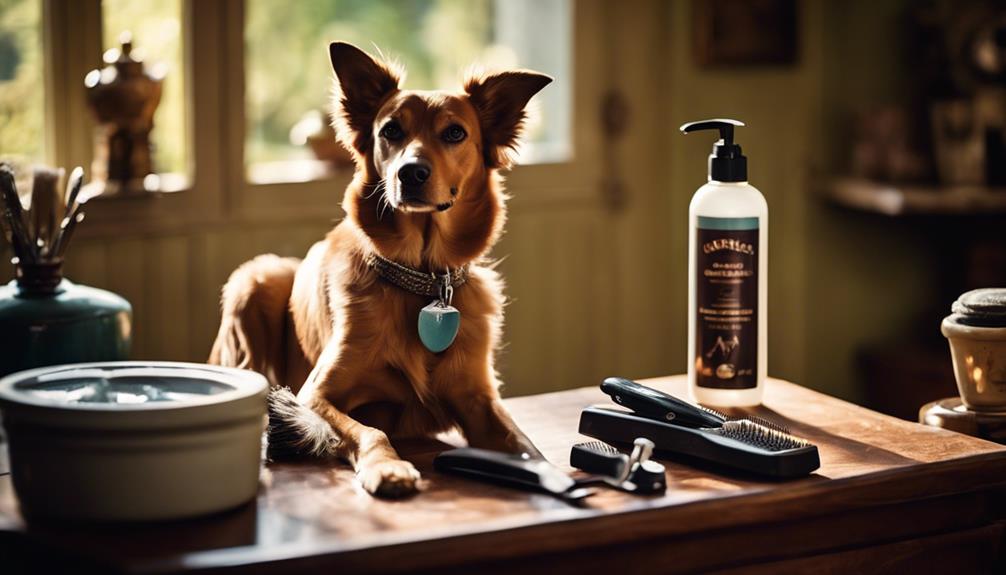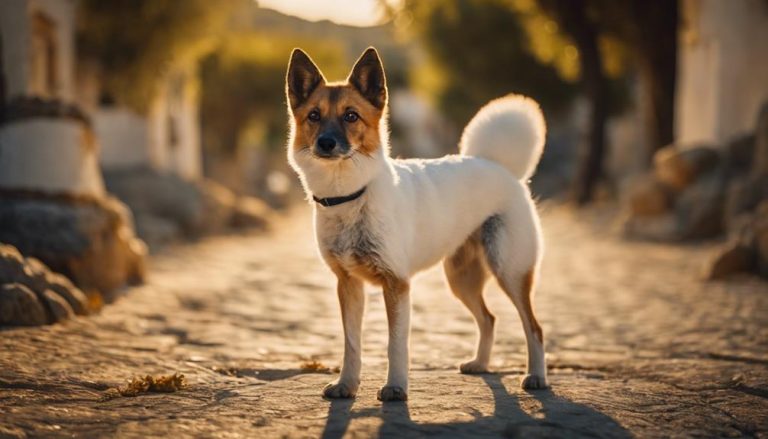Alopekis: Ancient Greek Dog Breed
The Alopekis is an ancient dog breed from Greece, known for its small size. They stand about 8-12 inches tall and weigh between 7-15 pounds. With a life expectancy of 12 to 15 years, these dogs are covered in a short, sleek coat that keeps them cool in hot weather. You can find them in colors like black, white, and tan.
These dogs are smart, alert, and friendly, making them great companions for kids and other pets. However, they can be a bit wary around strangers. They’re generally healthy, with few genetic issues to worry about. The Alopekis has a rich history in Greek culture, having been around for centuries.
Key Takeaways
- Alopekis are perfect for apartment life due to size.
- They’re smart, love kids, and get along with pets.
- Originating in Greece, valued for hunting and guarding skills.
Quick Facts
The Alopekis, a breed with deep roots in Greece, is a small yet sturdy dog. It measures about 8 to 12 inches in height and weighs around 7 to 15 pounds. This breed is known for its long lifespan, typically ranging from 12 to 15 years, which is impressive for its size. The Alopekis has a short and sleek coat that makes it both agile and easy to care for. Its coat is well-suited for the warm Mediterranean climate, helping it stay cool and healthy.
The coat of the Alopekis comes in a variety of colors including black, white, and tan, sometimes mixed. These colors not only make the Alopekis visually appealing but also reflect the breed’s history and adaptability to different environments in Greece. Despite its small stature, the Alopekis has a coat that protects it from the elements and predators, showcasing the breed’s resilience and adaptability.
Overview

The Alopekis, also known as the Small Greek Domestic Dog, shines in its intelligence and awareness. These traits not only highlight the dog’s usefulness in a variety of roles in its home country of Greece but also make it an excellent breed for families. The Alopekis is highly trainable, which means it fits well into household settings and builds strong connections with its owners.
This breed is friendly towards children and other pets, although it might be a bit reserved around new people. This cautious behavior doesn’t take away from its sociability; it actually shows how selective they are. A key point about the Alopekis is its health. Unlike many breeds, it doesn’t have a lot of common genetic issues. This points to the breed’s overall toughness and good prospects for long-term health.
Their adaptability, coupled with a friendly nature, makes the Alopekis a great option for those looking for a pet that captures the ancient Greek spirit and physical resilience.
Ancient Greek Origins
The Alopekis breed traces back to ancient Greece, predating the Mycenaean civilization which started around 1750 B.C. This makes it one of the first dog breeds to be domesticated in that area. The significance of this period lies in how it marks the beginning of the breed’s journey alongside humans, serving roles in hunting and as companions. Artifacts from the Neolithic era feature the earliest images of Alopekis dogs, showing they have been part of human life in Greece for a long time. These findings, along with mentions in classical texts, confirm the breed’s deep roots in history.
| Era | Description | Importance |
|---|---|---|
| Neolithic | Initial images of Alopekis dogs | Shows early domestication |
| Mycenaean Civilization | Dates back before Alopekis origins | Confirms the breed’s ancient background |
| Classical Period | Discussed by Aristotle and Xenophon | Emphasizes cultural and practical importance |
Notable Greek writers like Aristotle and Xenophon have written about the Alopekis. Xenophon, in his piece ‘Cynegeticus,’ described them as skilled hunting dogs in Greece. These references serve as evidence of the breed’s longstanding value and role in Greek society. Today, protecting the Alopekis breed is crucial due to its rich historical heritage and the recent decline in numbers following sterilization efforts. Preserving this breed helps maintain a connection to Greece’s ancient history.
Ancient Roots

Investigating the Alopekis’ ancient roots shows a rich history closely linked with the rise of human communities in Greece. This piece will cover the breed’s beginnings, its initial roles in these societies, and its lasting importance in ancient culture. We’ll look at:
- Where it Came From and Its Past
- Original Roles
- Importance in Culture
- Adjusting to Different Areas
- Influence on Greek Life
The Alopekis has a fascinating origin story, starting in the ancient Greek settlements. It wasn’t just a pet; it was a vital part of daily life. These dogs had several roles, from guarding homes to helping with hunting, showcasing their versatility and importance to early Greek communities.
Their significance went beyond practical uses. The Alopekis was deeply embedded in the culture, appearing in art and mythology, showing its symbolic value in ancient times. Its ability to adapt to various local environments made it indispensable, further cementing its place in Greek society.
The impact of the Alopekis on Greek life was profound. It wasn’t just about the tasks they performed but also the companionship they offered, strengthening the bond between humans and dogs. This relationship highlights the Alopekis’ lasting legacy in shaping human-animal connections in history.
Origin and History
The Alopekis breed has a history that reaches back to the Mycenaean era around 1750 B.C., showcasing its long-standing connection to Greece. This breed has been a part of Greek life since the Neolithic period and classical antiquity, evident in many ancient Greek sculptures that feature the Alopekis. Famous Greek writers like Aristotle and Xenophon have mentioned this breed in their works, with Xenophon’s Cynegeticus highlighting its hunting capabilities.
Despite facing challenges like a decreasing population due to sterilization efforts, there are current efforts to save this historic breed. These initiatives aim to protect the Alopekis’s ancient lineage and its importance in Greek culture, ensuring it remains a part of our world.
Early Functions
Originating from Greece, Alopekis dogs have been essential in hunting and as companions since ancient times. These dogs were highly valued not just for their company but also for their hunting skills.
In farms, Alopekis dogs played a crucial role in controlling pests and protecting poultry from predators, making them vital in agricultural activities. Their hunting skills were especially effective against rodents like rats, proving their worth in maintaining a pest-free environment.
Their ability to work alongside livestock guarding dogs demonstrated their adaptability. The Alopekis were also known as excellent watchdogs, proving their diverse capabilities within their native Greek setting.
Cultural Significance
Alopekis dogs, named after the Greek word for ‘small fox,’ are more than just pets in ancient Greek culture. These dogs were critical in many aspects of daily life, from hunting to protecting poultry from pests. They were so integral that famous Greek writers like Aristotle and Xenophon wrote about them.
Today, there’s a push to keep the Alopekis breed alive, not just to preserve their physical traits but also the values they represent: courage, strength, and the ability to adapt.
This effort is crucial because Alopekis dogs are becoming rare. Preserving them isn’t just about keeping a breed from extinction; it’s about holding onto a piece of Greek heritage. These dogs remind us of the resilience and ingenuity of ancient Greeks. By ensuring the survival of the Alopekis, we keep alive the stories and ideals that have shaped a culture, making sure they don’t just become forgotten tales of the past.
Compact Build

The Alopekis breed’s compact size is a big plus, especially for city dwellers. Being small to medium with a strong build makes them perfect for different types of homes, whether that’s an apartment or a house that doesn’t have much garden space. This size isn’t just good for fitting into living spaces; it also means they’re generally healthier and easier to look after.
- Perfect for Apartments
- Easy to Manage
- Requires Little Space
- Fits Well in Various Homes
- Positive Health Aspects
Their small stature means they’re easy to manage, whether that’s during a walk or when moving them from place to place. You won’t need a lot of space for them to feel at home, which is ideal if you’re living in a place where space is a premium.
The Alopekis is adaptable, fitting into various living situations with ease. Whether you’re in a small apartment or a larger home, they can make themselves comfortable. This adaptability extends to their health as well; their compact build generally leads to fewer health issues, making them not only a joy to have around but also a comparatively easy companion to care for.
Ideal Apartment Size
The Alopekis breed is perfect for apartment living due to its small size, often standing just 8 to 12 inches tall and weighing between 7 to 15 pounds. This makes it easy to handle in smaller spaces. But living in an apartment with an Alopekis is more than just about size. It’s also about making sure your neighbors are okay with your pet, which means focusing on noise control and teaching your dog how to behave well.
Training your Alopekis with apartment living in mind can make a big difference in how happy both you and your dog are. Simple steps to train them properly can ensure a peaceful coexistence with your neighbors and a comfortable home environment for your furry companion.
Ease of Handling
Alopekis dogs are known for their small size, making them incredibly easy to handle. This makes them perfect companions for those living in apartments or homes with limited space. Their small stature means they can easily be taken on trips, whether you’re walking or driving, fitting comfortably into various modes of transport.
These dogs are also highly adaptable, thriving in different living situations without needing a lot of room. They’re agile and can enjoy a variety of indoor activities, even in tight spaces. This adaptability, combined with their ability to navigate through different environments effortlessly, makes Alopekis dogs ideal for anyone looking for a low-maintenance pet.
Their compact build not only makes them easy to move around but also ensures they blend well into smaller living areas. Alopekis dogs can quickly become part of any family, thanks to their flexible nature. They’re also skilled at moving through different spaces with ease, which highlights their suitability for a wide range of homes.
Minimal Space Requirements
For those living in tight city spaces, the Alopekis dog breed is a perfect pet choice. They are small, standing only 8 to 12 inches tall and weighing 7 to 15 pounds, making them great for apartments.
Despite their size, they are full of energy and need regular activities to stay happy. This makes them a great match for city life where space is at a premium.
Choosing an Alopekis means you get a lively companion that fits well in smaller homes.
Adaptability to Living Spaces
Alopekis dogs are surprisingly good at fitting into different living spaces, including small city apartments. Their small size, usually standing between 8 to 12 inches tall, means they don’t need much room. This makes them great pets for apartment dwellers. But it’s not just about size. How much exercise they need and their behavior are also key to living happily in smaller spaces.
Training is crucial to make sure they know the rules of the home, which keeps everyone, including the neighbors, happy. This makes life in apartments better for both the dog and its owner. While Alopekis dogs do well in these settings, it’s worth noting that not every dog breed is as adaptable. Some need more room to run and more physical activity than you can provide in an apartment.
Health Implications
Understanding how Alopekis dogs adapt to different living spaces is crucial, especially when considering the health effects of their compact build. This build, while making them agile and athletic, comes with its own set of health considerations.
Their sturdy body not only makes them great at activities that require endurance, like agility training, but also helps them move easily across different types of terrain. This reduces the likelihood of injuries that more fragile breeds might face. Their compact size also contributes to their overall good health and endurance.
However, it’s important to keep an eye out for any health issues that could come up because of their unique body shape, ensuring they stay healthy whether they live in big houses or small apartments.
Cheerful Disposition

The Alopekis breed’s cheerful nature plays a crucial role in making them excellent family pets. Their happiness not only brightens the home but also positively affects the emotional health of those around them. The way this breed behaves and interacts highlights their ability to create a lively and joyful home environment.
- Traits of Joyfulness
Alopekis dogs are known for their playful and friendly demeanor. Their ability to remain upbeat helps maintain a positive atmosphere at home.
- Daily Mood Boost
Having an Alopekis around can significantly uplift your mood. Their constant energy and willingness to play make every day a little brighter.
- Benefits in Socializing
These dogs are great at making friends, both with humans and other pets. They naturally encourage more social interactions, which is great for their owners’ social life.
- Influence of Positive Energy
The positive energy an Alopekis brings into a home is infectious. It encourages everyone in the household to adopt a more optimistic outlook on life.
- Signs of Happiness through Tail-Wagging
One unmistakable sign of their happiness is their constant tail-wagging. It’s a clear indicator of their contentment and joy, making it impossible not to smile in response.
In essence, the Alopekis breed’s ability to spread joy and positivity makes them more than just pets; they’re a source of happiness and emotional support for the whole family.
Joyful Nature Traits
Alopekis dogs are known for their joyful and cheerful nature, making them perfect pets for both individuals and families looking for a lively addition to their lives. These dogs are playful and full of life, bringing a sense of happiness wherever they go. Their positive attitude helps improve the mood in any home, making them cherished members of the family. They are also very loving, which adds to their appeal as companions.
The combination of their affectionate behavior and happy demeanor makes Alopekis dogs great for families wanting a pet that adds energy and joy to their daily routine. Their ability to constantly bring smiles and laughter highlights their role as a source of happiness.
Enhancing Mood Daily
Spending time with an Alopekis can significantly improve your mood, creating a happier atmosphere at home. These dogs are playful and loving, offering emotional support and a fun way to stay mentally engaged through training. Their loyal and affectionate nature helps reduce stress and anxiety, making you feel better overall. Having an energetic Alopekis around adds excitement to daily life, lifting your spirits.
The Alopekis breed stands out for its ability to positively affect mental health. Through their loyalty, love, and playfulness, they play a key role in enhancing happiness and promoting a positive home environment.
Social Interaction Benefits
The Alopekis dogs are known for their cheerful and energetic nature, which plays a significant role in enhancing social interactions within a family. These dogs love being part of family activities and easily pick up on social cues, making them great companions. Their ability to adjust to different situations, combined with their loyalty and protective nature, strengthens family bonds. The Alopekis is also very affectionate, encouraging a warm and loving environment at home.
This breed’s playful temperament not only keeps the atmosphere light but also promotes spending quality time together. Their eagerness to participate and show affection makes them perfect for fostering closer relationships among family members. This, in turn, supports a healthy, interactive, and supportive living environment, proving that Alopekis dogs are more than just pets; they’re catalysts for stronger family connections.
Positive Energy Influence
Alopekis dogs are known for their joyful nature, which really brightens up family life. Their love for fun and games adds a lively vibe to any home. These dogs are not only affectionate and loyal, making them great companions, but their playful behavior and protective instincts make them much more than just pets. They’re valued family members.
Their alertness and smartness mean they’re great at adjusting to different situations, bringing happiness wherever they go. Alopekis dogs are excellent at making strong connections with their owners, boosting the overall positive atmosphere at home.
Tail-Wagging Happiness Signals
In Alopekis dogs, the way they wag their tails tells us a lot about how they’re feeling. Whether they’re happy, excited, or just looking for some fun, their tail movement is a key sign of their mood. This action, where their tail moves side to side, shows they’re in a good mood and want to interact, either with people or other pets. It’s their way of saying they’re up for playing or just want some attention.
This tail-wagging does more than just show they’re ready to have fun. It’s also a way for them to communicate with us. It helps strengthen the bond between Alopekis dogs and their owners, showing off their friendly and loving nature. So, when you see an Alopekis wagging its tail, it’s not just a simple gesture. It’s a complex way of expressing their feelings and desires, making the connection with their human friends even stronger.
Genetic Health Concerns

Paying close attention to genetic health in Alopekis dogs is crucial for their overall well-being. Health screenings are key for spotting and managing any inherited conditions early on. This proactive approach is vital for ensuring these dogs enjoy a long and happy life.
Genetic Disorders: It’s rare, but keeping an eye out for hereditary problems is a smart move.
Health Screenings: Getting these dogs checked regularly can help catch issues early, leading to better health outcomes.
Preventive Care: Combining a good diet, regular exercise, and timely vaccinations can help prevent many problems.
Diet and Exercise: Keeping these dogs active and on a healthy diet helps avoid diseases related to being overweight.
Training and Socialization: Starting training and socialization early is great for their mental health and can help lower stress.
Health screenings are crucial for spotting any potential problems before they become serious. Regular check-ups can make a big difference in a dog’s health. Offering a balanced diet and plenty of exercise is also key to preventing health issues, especially those related to obesity. Moreover, early training and proper socialization can significantly improve a dog’s mental well-being and reduce stress.
Common Genetic Disorders
The Alopekis breed stands out due to its exceptional health and lack of common genetic problems. This makes them incredibly strong and contributes to their longer lives.
Still, they might face some rare genetic issues, which makes regular vet visits crucial. These check-ups help catch and manage any potential health problems early on.
Owners should also ensure their Alopekis have a healthy diet, plenty of exercises, and proper preventive care. This combination helps protect them from the few health risks they might face and supports their overall vitality and longevity.
Health Screening Importance
Regular health checks are crucial for the Alopekis breed, despite their overall good health. These checks can spot genetic issues early on, such as hip dysplasia, knee problems, and eye conditions.
With genetic testing, breeders can make better choices to improve the breed’s health. This helps reduce hereditary diseases. Early discovery of these issues means they can be managed more effectively, leading to healthier lives for these dogs.
Preventive Care Strategies
Implementing thorough genetic health screenings is a key strategy for spotting and managing possible genetic disorders in Alopekis dogs. Through these screenings, breeders and veterinarians can identify breed-specific conditions like hip dysplasia and heart problems early on. Responsible breeding is critical in lowering the number of these genetic health issues within the breed. By avoiding known genetic risks, breeders can improve the health of the Alopekis population.
Working closely with a veterinarian to create a customized preventive care plan is essential for early detection and treatment of genetic health problems. This method not only makes managing these conditions more likely to succeed but also greatly improves the life quality for Alopekis dogs with these issues.
Grooming Essentials

Caring for an Alopekis means knowing its specific needs and coat type. A proper grooming routine not only makes the dog look good but also keeps it healthy and comfortable. This involves everything from taking care of its fur to basic hygiene that helps prevent infections.
Coat care is essential. Depending on the Alopekis’s coat type, you might need different tools and techniques to keep its fur in top condition. Regular brushing removes tangles and reduces shedding.
Keeping the nails trimmed is more than just for looks; it’s vital for the dog’s mobility and comfort. Nail trimming should be done with care to avoid cutting too short and causing pain.
Ear cleaning is crucial to prevent infections, especially in breeds prone to ear problems. Gently cleaning the ears can keep them healthy and free from issues.
Bathing your Alopekis doesn’t have to be a frequent task. The right bathing schedule depends on the dog’s lifestyle and skin needs. Using a mild dog shampoo will keep its coat shiny without drying out the skin.
Choosing the right brush is important for effective grooming. Different coats require different types of brushes for the best results. A good brush removes dead hair, detangles, and spreads natural oils through the coat.
Coat Care Tips
Taking care of an Alopekis’ coat is essential for their health and looks. It involves brushing them regularly, using the right grooming tools, and bathing them the right way. Depending on whether they have short, semi-long, or wired hair, you’ll need different strategies to avoid tangles and keep them clean. For instance, slicker brushes work great for detangling and getting rid of loose fur, while combs are better for the finer details, especially with semi-long or wired coats.
Giving your dog regular baths with shampoos made for dogs helps keep their coat shiny and healthy. Sometimes, they might also need a trim to stay looking their best. By staying on top of these grooming tasks, you ensure your Alopekis looks and feels great. This kind of care shows just how much you value their well-being.
Nail Trimming Routine
Taking care of an Alopekis’s coat is crucial, but nail trimming also plays a key role in their health and ease of movement. To avoid nails getting too long and causing discomfort, trim them every 2-4 weeks. Letting their nails overgrow can lead to soreness, changes in how they walk, and even joint problems, all of which can negatively impact their life.
Using the right nail clippers and knowing how to trim correctly are important to prevent hurting the quick—a painful experience for your dog. If you’re not confident in doing it yourself, it’s a good idea to get help from a professional groomer or vet. This ensures your Alopekis stays comfortable and safe during their grooming routine.
Ear Cleaning Guide
Keeping your dog’s ears clean is crucial for their health, especially for breeds like the Alopekis. It helps prevent infections and maintains their hearing health. Use a vet-approved ear cleaner and softly wipe the outer part of their ear with cotton balls. It’s important not to push anything into their ear canal, as this could cause damage.
Avoid using cotton swabs in your dog’s ears; they can harm the inner parts of the ear. Watch out for symptoms like redness, discharge, or your dog scratching their ear more than usual. These could be signs of an issue. If you notice any of these, get in touch with your vet right away for advice and treatment to keep your dog’s ears healthy.
Bathing Frequency Advice
For the Alopekis dog breed, known for its low grooming needs, a bath every 2-3 months works well. This schedule keeps their coat clean and their skin healthy without disturbing the natural oils that protect them.
Because they are easy to care for, regular brushing is crucial. Brushing helps to get rid of any loose hair and dirt, which means you can wait longer between baths. This not only keeps their coat looking good but also spreads their skin’s natural oils, keeping their skin healthy.
When it’s time for a bath, choosing a gentle dog shampoo made for their specific coat type is key. This careful choice helps avoid skin irritation and keeps their protective oil barrier intact. This approach is all about maintaining their well-being with minimal fuss.
Brush Selection Guide
Choosing the right grooming tool for your Alopekis is key to keeping their coat and skin in top condition. A slicker brush is a must-have for working out tangles and preventing mats, keeping their fur soft and easy to manage.
If you want to make sure their coat shines and feels great, use a bristle brush to spread their natural oils.
To tackle shedding, adding a shedding blade to your grooming kit can really cut down on the amount of loose hair. For a versatile option, consider a grooming glove. It’s not only gentle on their skin but also effective at picking up loose fur.
A pin brush will help make your Alopekis look their best, adding volume to their coat and helping with styling for a polished look. Regular use of these tools is crucial for maintaining your Alopekis’s coat health.
Dietary Recommendations

When it comes to feeding Alopekis dogs, understanding their dietary needs is critical for their health and energy. It’s all about balancing the right nutrients, being aware of allergies, and choosing between homemade and store-bought foods. These steps ensure they stay healthy and lively.
- Nutritional Needs
- Food Allergies
- Homemade vs. Store-Bought Foods
- Health and Energy Benefits
- Careful Feeding Plans
For Alopekis dogs, getting their diet right means focusing on their specific nutritional needs. This involves knowing what vitamins, minerals, and types of food best support their health. It also means recognizing common allergies that could harm them, ensuring their diet avoids these triggers.
The debate between feeding your Alopekis homemade meals or buying commercial dog food is significant. Homemade meals can be tailored to your dog’s needs but require more time and knowledge to prepare correctly. On the other hand, commercial dog foods are convenient and often meet nutritional standards but may contain fillers and additives that aren’t ideal.
Choosing the right diet impacts their overall well-being. A balanced diet supports a healthy weight, shiny coat, and ample energy for daily activities. It requires a thoughtful feeding plan that considers the dog’s age, activity level, and health conditions.
Optimal Nutrition Needs
Ensuring your Alopekis dog is getting the right nutrition is key to their health and happiness. They need about 1/2 to 1 1/2 cups of high-quality dog food each day, depending on their age, size, and how active they are. This helps prevent overfeeding, which can lead to weight problems and affect their overall health.
It’s crucial to provide a diet that meets their specific needs, which might include special requirements due to any health issues or breed-specific predispositions. A well-thought-out diet supports their energy needs and contributes to their long-term well-being, making sure they stay healthy and active.
Common Food Allergies
Understanding the dietary needs of Alopekis dogs is crucial, especially when it comes to food allergies. Some of the common triggers include beef, chicken, dairy, wheat, and soy, which could cause uncomfortable reactions in these pets. To keep Alopekis safe, vets often suggest feeding them hypoallergenic dog food or meals that contain only a few ingredients. These diets are specially made to leave out the usual allergens, offering a more secure food option.
Talking to a vet is key to properly figure out and handle these allergies. Keeping a food diary and using an elimination diet are effective ways to find out which specific foods are causing problems. It’s also a good idea to switch up the protein sources in their diet and stay away from artificial additives. These steps can help manage the Alopekis’s food sensitivities, ultimately improving their health and happiness.
Homemade Vs. Commercial Foods
Choosing the right diet for Alopekis dogs means balancing home-cooked meals with the ease of store-bought foods. Home-cooked options can be rich in nutrients, consisting of lean meats, vegetables, and grains. These meals require careful planning and a vet’s guidance to ensure they meet all dietary needs.
On the other hand, store-bought dog foods are crafted to fulfill the Alopekis’s nutritional requirements, with extra vitamins and minerals for a complete diet. They are easy to use and provide consistent nutrition.
A practical approach might involve mixing home-cooked and store-bought foods. This can give your Alopekis a variety of flavors and nutrients, catering to their dietary needs effectively.
Frequently Asked Questions
What Does the Name Alopekis Mean?
- Alopekis traces back to Greek, meaning small fox.
- It showcases the breed’s fox-like features.
- Historically, it’s highlighted in classical literature.

